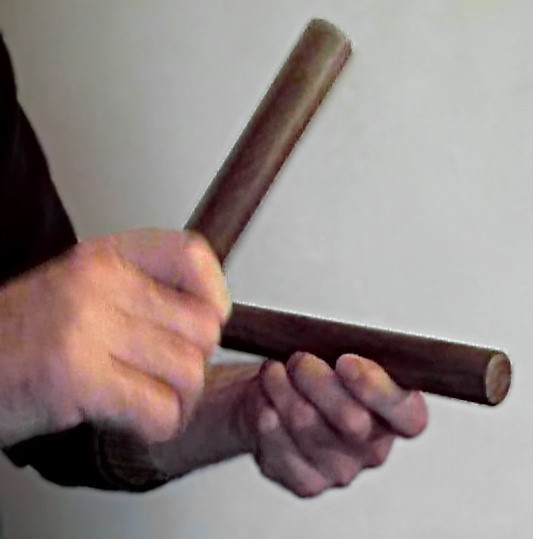
Clave (rhythm)
The clave (/ˈklɑːveɪ, kleɪv/; Spanish: [ˈklaβe])[1] is a rhythmic pattern used as a tool for temporal organization in Brazilian and Cuban music. In Spanish, clave literally means key, clef, code, or keystone. It is present in a variety of genres such as Abakuá music, rumba, conga, son, mambo, salsa, songo, timba and Afro-Cuban jazz. The five-stroke clave pattern represents the structural core of many Cuban rhythms.[2] The study of rhythmic methodology, especially in the context of Afro-Cuban music, and how it influences the mood of a piece is known as clave theory.
This article is about the rhythmic pattern. For the musical instrument used to play it, see Claves.
The clave pattern originated in sub-Saharan African music traditions, where it serves essentially the same function as it does in Cuba. In ethnomusicology, clave is also known as a key pattern,[3][4] guide pattern,[5] phrasing referent,[6] timeline,[7] or asymmetrical timeline.[8] The clave pattern is also found in the African diaspora music of Haitian Vodou drumming, Afro-Brazilian music, African-American music, Louisiana Voodoo drumming, and Afro-Uruguayan music (candombe). The clave pattern (or hambone, as it is known in the United States) is used in North American popular music as a rhythmic motif or simply a form of rhythmic decoration.
The historical roots of the clave are linked to transnational musical exchanges within the African diaspora. For instance, influences of the African “bomba” rhythm are reflected in the clave. In addition to this, the emphasis and role of the drum within the rhythmic patterns speaks further to these diasporic roots.[9]
The clave is the foundation of reggae, reggaeton, and dancehall. In this sense, it is the “heartbeat” that underlies the essence of these genres.[9] The rhythms and vibrations are universalized in that they demonstrate a shared cultural experience and knowledge of these roots. Ultimately, this embodies the diasporic transnational exchange.
In considering the clave as this basis of cultural understanding, relation, and exchange, this speaks to the transnational influence and interconnectedness of various communities. This musical fusion is essentially what constitutes the flow and foundational “heartbeat” of a variety of genres.
Etymology[edit]
Clave is a Spanish word meaning 'code,' 'key,' as in key to a mystery or puzzle, or 'keystone,' the wedge-shaped stone in the center of an arch that ties the other stones together. The rhythm also gave the name to the claves Afro-Cuban musical instrument which consists of a pair of hardwood sticks.[10]
Types[edit]
Son clave[edit]
The most common clave pattern used in Cuban popular music is called the son clave, named after the Cuban musical genre of the same name. Clave is the basic period, composed of two rhythmically opposed cells, one antecedent and the other consequent.[d][e] Clave was initially written in two measures of 2
4 in Cuban music.[31] When written this way, each cell or clave half is represented within a single measure.
In non-Cuban music[edit]
Controversy over use and origins[edit]
Perhaps the greatest testament to the musical vitality of the clave is the spirited debate it engenders, both in terms of musical usage and historical origins. This section presents examples from non-Cuban music, which some musicians (not all) hold to be representative of the clave. The most common claims, those of Brazilian and subsets of American popular music, are described below.